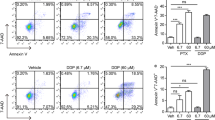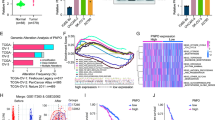Abstract
Tumor necrosis factor-related apoptosis-inducing ligand (TRAIL) has been identified as a promising anti-tumor agent against in a variety of cancers. However, gastric cancer cells are less sensitive than other cancer cells to TRAIL-induced apoptosis. Here, we combined TRAIL with kurarinone, a natural compound, to induce apoptosis in gastric cancer cell lines SGC7901. After the cells were treated with TRAIL and/or kurarinone, the cell viability and apoptosis were examined by MTT and flow cytometry, respectively. The expression of apoptosis-associated proteins was determined by western blot and q-RT-PCR. Kurarinone at low concentration significantly potentiated the cytotoxic effect of TRAIL by enhancing apoptosis as well as cell cycle arrest at G2/Mphase. The enhancement of apoptosis TRAIL induced by kurarinone involved downregulation of anti-apoptotic proteins Mcl-1 and c-FLIP as well as inhibition of STAT3 signaling. Moreover, we found that STAT3 inhibitor could synergistically enhanced TRAIL-induced apoptosis, similar to kurarinone. Kurarinone synergizes TRAIL-induced apoptosis in human gastric cancer cells. The synergistic effect between these two drugs is associated with downregulation of Mcl-1 and c-FLIP via inhibiting STAT3 signaling. The combination of TRAIL and kurarinone might be an effective regimen for the treatment of advanced gastric cancer.



Similar content being viewed by others
References
Jemal, A., Bray, F., Center, M. M., Ferlay, J., Ward, E., & Forman, D. (2011). Global cancer statistics, CA: A cancer. Journal for Clinicians, 61, 69–90.
Shin, A., Kim, J., & Park, S. (2011). Gastric cancer epidemiology in Korea. Journal of Gastric Cancer, 11, 135–140.
Bilici, A., Selcukbiricik, F., Demir, N., Oven Ustaalioglu, B. B., Dikilitas, M., & Yildiz, O. (2014). Modified docetaxel and cisplatin in combination with capecitabine (DCX) as a first-line treatment in HER2-negative advanced gastric cancer. Asian Pacific Journal of Cancer Prevention: APJCP, 15, 8661–8666.
Liu, J., Qu, X. J., Xu, L., Zang, Y., Qu, J. L., Hou, K. Z., & Liu, Y. P. (2010). Bortezomib synergizes TRAIL-induced apoptosis in gastric cancer cells. Digestive Diseases and Sciences, 55, 3361–3368.
Smyth, E. C., & Cunningham, D. (2012). Targeted therapy for gastric cancer. Current Treatment Options in Oncology, 13, 377–389.
Wong, H., & Yau, T. (2013). Molecular targeted therapies in advanced gastric cancer: Does tumor histology matter? Therapeutic Advances in Gastroenterology, 6, 15–31.
Nadauld, L. D., & Ford, J. M. (2013). Molecular profiling of gastric cancer: Toward personalized cancer medicine. Journal of Clinical Oncology: Official Journal of the American Society of Clinical Oncology, 31, 838–839.
Trarbach, T., Moehler, M., Heinemann, V., Kohne, C. H., Przyborek, M., Schulz, C., et al. (2010). Phase II trial of mapatumumab, a fully human agonistic monoclonal antibody that targets and activates the tumour necrosis factor apoptosis-inducing ligand receptor-1 (TRAIL-R1), in patients with refractory colorectal cancer. British Journal of Cancer, 102, 506–512.
Greco, F. A., Bonomi, P., Crawford, J., Kelly, K., Oh, Y., Halpern, W., et al. (2008). Phase 2 study of mapatumumab, a fully human agonistic monoclonal antibody which targets and activates the TRAIL receptor-1, in patients with advanced non-small cell lung cancer. Lung Cancer, 61, 82–90.
Younes, A., Vose, J. M., Zelenetz, A. D., Smith, M. R., Burris, H. A., Ansell, S. M., et al. (2010). A Phase 1b/2 trial of mapatumumab in patients with relapsed/refractory non-Hodgkin’s lymphoma. British Journal of Cancer, 103, 1783–1787.
Cho, I. R., Koh, S. S., Min, H. J., Park, E. H., Srisuttee, R., Jhun, B. H., et al. (2010). Reovirus infection induces apoptosis of TRAIL-resistant gastric cancer cells by down-regulation of Akt activation. International Journal of Oncology, 36, 1023–1030.
Nam, S. Y., Jung, G. A., Hur, G. C., Chung, H. Y., Kim, W. H., Seol, D. W., & Lee, B. L. (2003). Upregulation of FLIP(S) by Akt, a possible inhibition mechanism of TRAIL-induced apoptosis in human gastric cancers. Cancer Science, 94, 1066–1073.
Kim, B. H., Na, K. M., Oh, I., Song, I. H., Lee, Y. S., Shin, J., & Kim, T. Y. (2013). Kurarinone regulates immune responses through regulation of the JAK/STAT and TCR-mediated signaling pathways. Biochemical Pharmacology, 85, 1134–1144.
Park, S. J., Nam, K. W., Lee, H. J., Cho, E. Y., Koo, U., & Mar, W. (2009). Neuroprotective effects of an alkaloid-free ethyl acetate extract from the root of Sophora flavescens Ait. against focal cerebral ischemia in rats. Phytomedicine : International Journal of Phytotherapy and Phytopharmacology, 16, 1042–1051.
Jeong, G. S., Li, B., Lee, D. S., Byun, E., An, R. B., Pae, H. O., et al. (2008). Lavandulyl flavanones from Sophora flavescens protect mouse hippocampal cells against glutamate-induced neurotoxicity via the induction of heme oxygenase-1. Biological & Pharmaceutical Bulletin, 31, 1964–1967.
De Naeyer, A., Vanden Berghe, W., Pocock, V., Milligan, S., Haegeman, G., & De Keukeleire, D. (2004). Estrogenic and anticarcinogenic properties of kurarinone, a lavandulyl flavanone from the roots of Sophora flavescens. Journal of Natural Products, 67, 1829–1832.
Jeong, T. S., Ryu, Y. B., Kim, H. Y., Curtis-Long, M. J., An, S. J., Lee, J. H., et al. (2008). Low density lipoprotein (LDL)-antioxidant flavonoids from roots of Sophora flavescens. Biological & Pharmaceutical Bulletin, 31, 2097–2102.
Kim, S. J., Son, K. H., Chang, H. W., Kang, S. S., & Kim, H. P. (2003). Tyrosinase inhibitory prenylated flavonoids from Sophora flavescens. Biological & Pharmaceutical Bulletin, 26, 1348–1350.
Son, J. K., Park, J. S., Kim, J. A., Kim, Y., Chung, S. R., & Lee, S. H. (2003). Prenylated flavonoids from the roots of Sophora flavescens with tyrosinase inhibitory activity. Planta Medica, 69, 559–561.
Kim, J. H., Ryu, Y. B., Kang, N. S., Lee, B. W., Heo, J. S., Jeong, I. Y., & Park, K. H. (2006). Glycosidase inhibitory flavonoids from Sophora flavescens. Biological & Pharmaceutical Bulletin, 29, 302–305.
Berghe, W. V., De Naeyer, A., Dijsselbloem, N., David, J. P., De Keukeleire, D., & Haegeman, G. (2011). Attenuation of ERK/RSK2-driven NFkappaB gene expression and cancer cell proliferation by kurarinone, a lavandulyl flavanone isolated from Sophora flavescens ait. roots. Endocrine, Metabolic & Immune Disorders: Drug Targets, 11, 247–261.
Kang, T. H., Jeong, S. J., Ko, W. G., Kim, N. Y., Lee, B. H., Inagaki, M., et al. (2000). Cytotoxic lavandulyl flavanones from Sophora flavescens. Journal of Natural Products, 63, 680–681.
Cho, Y. L., Lee, K. S., Lee, S. J., Namkoong, S., Kim, Y. M., Lee, H., et al. (2005). Amiloride potentiates TRAIL-induced tumor cell apoptosis by intracellular acidification-dependent Akt inactivation. Biochemical and Biophysical Research Communications, 326, 752–758.
Aggarwal, B. B., Kunnumakkara, A. B., Harikumar, K. B., Gupta, S. R., Tharakan, S. T., Koca, C., et al. (2009). Signal transducer and activator of transcription-3, inflammation, and cancer: How intimate is the relationship? Annals of the New York Academy of Sciences, 1171, 59–76.
Koyama, S., Koike, N., & Adachi, S. (2002). Expression of TNF-related apoptosis-inducing ligand (TRAIL) and its receptors in gastric carcinoma and tumor-infiltrating lymphocytes: A possible mechanism of immune evasion of the tumor. Journal of Cancer Research and Clinical Oncology, 128, 73–79.
Krieg, A., Mersch, S., Wolf, N., Stoecklein, N. H., Verde, P. E., Am Esch, J. S., II, Heikaus, S., Gabbert, H. E., Knoefel, W. T., & Mahotka, C. (2013). Expression of TRAIL-splice variants in gastric carcinomas: Identification of TRAIL-gamma as a prognostic marker. BMC Cancer, 13 (2013) 384.
Wu, P., Cheng, Y. W., Wang, J. Y., Zhang, X. D., & Zhang, L. J. (2014). Inhibition of MEK sensitizes gastric cancer cells to TRAIL-induced apoptosis. Neoplasma, 61, 136–143.
Xu, L., Hu, X., Qu, X., Hou, K., Zheng, H., & Liu, Y. (2013). Cetuximab enhances TRAIL-induced gastric cancer cell apoptosis by promoting DISC formation in lipid rafts. Biochemical and Biophysical Research Communications, 439, 285–290.
Yang, L., Lan, C., Fang, Y., Zhang, Y., Wang, J., Guo, J., et al. (2013). Sodium nitroprusside (SNP) sensitizes human gastric cancer cells to TRAIL-induced apoptosis. International Immunopharmacology, 17, 383–389.
Li, Y., Fang, H., & Xu, W. (2007). Recent advance in the research of flavonoids as anticancer agents. Mini Reviews in Medicinal Chemistry, 7, 663–678.
Jin, C. Y., Park, C., Cheong, J., Choi, B. T., Lee, T. H., Lee, J. D., et al. (2007). Genistein sensitizes TRAIL-resistant human gastric adenocarcinoma AGS cells through activation of caspase-3. Cancer Letters, 257, 56–64.
Zhou, Y., Tian, L., Long, L., Quan, M., Liu, F., & Cao, J. (2013). Casticin potentiates TRAIL-induced apoptosis of gastric cancer cells through endoplasmic reticulum stress. PLoS ONE, 8, e58855.
Pitti, R. M., Marsters, S. A., Ruppert, S., Donahue, C. J., Moore, A., & Ashkenazi, A. (1996). Induction of apoptosis by Apo-2 ligand, a new member of the tumor necrosis factor cytokine family. The Journal of Biological Chemistry, 271, 12687–12690.
Wiley, S. R., Schooley, K., Smolak, P. J., Din, W. S., Huang, C. P., Nicholl, J. K., et al. (1995). Identification and characterization of a new member of the TNF family that induces apoptosis. Immunity, 3, 673–682.
Ashkenazi, A., Pai, R. C., Fong, S., Leung, S., Lawrence, D. A., Marsters, S. A., et al. (1999). Safety and antitumor activity of recombinant soluble Apo2 ligand. The Journal of Clinical Investigation, 104, 155–162.
Walczak, H., Miller, R. E., Ariail, K., Gliniak, B., Griffith, T. S., Kubin, M., et al. (1999). Tumoricidal activity of tumor necrosis factor-related apoptosis-inducing ligand in vivo. Nature Medicine, 5, 157–163.
Dimberg, L. Y., Anderson, C. K., Camidge, R., Behbakht, K., Thorburn, A., & Ford, H. L. (2013). On the TRAIL to successful cancer therapy? Predicting and counteracting resistance against TRAIL-based therapeutics. Oncogene, 32, 1341–1350.
Gong, B., & Almasan, A. (2000). Apo2 ligand/TNF-related apoptosis-inducing ligand and death receptor 5 mediate the apoptotic signaling induced by ionizing radiation in leukemic cells. Cancer Research, 60, 5754–5760.
Srivastava, R. K. (2001). TRAIL/Apo-2L: mechanisms and clinical applications in cancer. Neoplasia, 3, 535–546.
Wei, M. C., Zong, W. X., Cheng, E. H., Lindsten, T., Panoutsakopoulou, V., Ross, A. J., et al. (2001). Proapoptotic BAX and BAK: A requisite gateway to mitochondrial dysfunction and death. Science, 292, 727–730.
Tan, M. L., Ooi, J. P., Ismail, N., Moad, A. I., & Muhammad, T. S. (2009). Programmed cell death pathways and current antitumor targets. Pharmaceutical Research, 26, 1547–1560.
Wu, G. S. (2009). TRAIL as a target in anti-cancer therapy. Cancer Letters, 285, 1–5.
Seo, O. W., Kim, J. H., Lee, K. S., Lee, K. S., Kim, J. H., Won, M. H., et al. (2012). Kurarinone promotes TRAIL-induced apoptosis by inhibiting NF-kappaB-dependent cFLIP expression in HeLa cells. Experimental & Molecular Medicine, 44, 653–664.
Kang, Y. J., Kim, I. Y., Kim, E. H., Yoon, M. J., Kim, S. U., Kwon, T. K., & Choi, K. S. (2011). Paxilline enhances TRAIL-mediated apoptosis of glioma cells via modulation of c-FLIP, survivin and DR5. Experimental & Molecular Medicine, 43, 24–34.
Murphy, A. C., Weyhenmeyer, B., Noonan, J., Kilbride, S. M., Schimansky, S., Loh, K. P., et al. (2014). Modulation of Mcl-1 sensitizes glioblastoma to TRAIL-induced apoptosis. Apoptosis : An International Journal on Programmed Cell Death, 19, 629–642.
Niu, G., Wright, K. L., Huang, M., Song, L., Haura, E., Turkson, J., et al. (2002). Constitutive Stat3 activity up-regulates VEGF expression and tumor angiogenesis. Oncogene, 21, 2000–2008.
Lirdprapamongkol, K., Sakurai, H., Abdelhamed, S., Yokoyama, S., Athikomkulchai, S., Viriyaroj, A., et al. (2013). Chrysin overcomes TRAIL resistance of cancer cells through Mcl-1 downregulation by inhibiting STAT3 phosphorylation. International Journal of Oncology, 43, 329–337.
Carlisi, D., D’Anneo, A., Angileri, L., Lauricella, M., Emanuele, S., Santulli, A., et al. (2011). Parthenolide sensitizes hepatocellular carcinoma cells to TRAIL by inducing the expression of death receptors through inhibition of STAT3 activation. Journal of Cellular Physiology, 226, 1632–1641.
Author information
Authors and Affiliations
Corresponding author
Rights and permissions
About this article
Cite this article
Zhou, W., Cao, A., Wang, L. et al. Kurarinone Synergizes TRAIL-Induced Apoptosis in Gastric Cancer Cells. Cell Biochem Biophys 72, 241–249 (2015). https://doi.org/10.1007/s12013-014-0444-0
Published:
Issue Date:
DOI: https://doi.org/10.1007/s12013-014-0444-0




